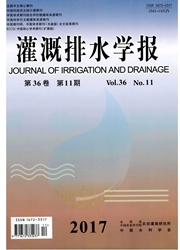

 中文摘要:
中文摘要:
研究了在不同初始盐度造墒条件下,滨海盐碱地覆膜棉田水盐分布及棉花生长动态特征。结果表明,棉花生育期结束后,经雨季淋洗T、D1、D2、D3处理0-40cm土层土壤电导率分别降低了40.60%、37.04%、45.12%、57.56%,0-100cm土层土壤脱盐率分别为33.02%、32.78%、28.19%和34.37%。D3处理干物质总量分别比T、D1和D2处理降低了98.09%、120.21%、76.34%。产量以D1处理最高(3 156.78kg/hm2),D3处理最低,较D1处理减少了30.25%;T处理纤维品质为B级,优于其他处理(均为C级),不同处理间断裂比强度、伸长率等差异不明显。降水对0-40cm土层内盐分淋洗效果明显,咸水滴灌未对棉花产量产生不利影响。
 英文摘要:
英文摘要:
Field experiments were conducted to study the water and salt distributions and growth character- istics under different soil salinity. The results showed that, compared with those in the driest situation, due to leaching after rainy season,the soil ratio of desalinization of 0-100 cm layer under T, Da, Dz andD3 treatments decreased by 33.02%, 32.78%, 28. 19% and 34.37%, and electronic conductivity (ECs) of 0-40 crn layer decreased by 40. 60%, 37.04%, 45. 12% and 57. 56%, respectively. Dry matter in Da treatment decreased by 98.09%, 120.21%, 76.34% compared to T, D1, D2 treatments, and there was no significant difference between D- and D2 treatments. The yield in Da treatment was the lowest, and de- creased by 30.25- compared to that in D1 treatment with the top yield of 3 156.78 kg/hm2. Fiber quality in the T treatment was B grade, which was better than other treatments with drip irrigation, however, there was no significant difference in specific breaking strength and elongation indexes. Heavy rain would significantly lower the EC- of 0-40 cm layer, and drip irrigation with saline water and increase cotton yield in wet year.
 同期刊论文项目
同期刊论文项目
 同项目期刊论文
同项目期刊论文
 期刊信息
期刊信息
